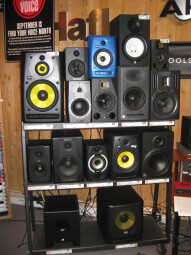So, you have made a first selection of several speaker models, you have found a shop (or a friend) who has them and now you only have to listen to them... But what should you listen to?
A/B test
The A/B test is the only way to compare different speakers effectively. In other words, you should have the possibility to switch between several monitor pairs in a split second using a switch or a remote control. People say that the human ear has no memory, so a couple of minutes are enough to forget the sound of a speaker. Moreover, when it comes to comparison of details, it becomes crucial to have the possibility to switch quickly between several speakers.
Where and how?
The room where you test the monitors influences the sound of the speakers, so it’s recommended to have the listening session in an acoustically treated room. Some shops even have a real auditorium, so make use of such opportunities! Check the position of the speakers so that none of them is significantly better placed than the others: make sure that the distance and the angle of all speakers is the same in relation to your ears. If some speakers are too close or too far to the sides, this may distort the stereo image. Arrange the monitors in staggered rows so that the angle between both speakers of each pair is always the same. Do note that you’ll have to move your head each time you switch the monitor pair so that you always stay in the center of the sweet spot.
Louder sounds better
Make sure to set the volume of the speakers properly: if one pair sounds louder than the others, you’ll automatically feel that it sounds better. Unconsciously, everything louder sounds better. You can’t do anything about that, it’s in our nature! Choose the lead instrument or vocals as loudness reference and ensure that it’s the same for all speaker pairs.
Reference CD
The source is very important when comparing speakers, both regarding signal quality (avoid MP3 files @ 64 kbit/s and old cassettes) and diversity. Listen to different music styles: classical music, electronic, metal… Some music genres are interesting for their dynamics (classical music), their detailed sound information or their frequency range. It’s also important to know very well the tracks you want to use as a reference. You might even want to select them according to specific details (for instance, a song with a huge bass line!).
Details
It might be interesting to focus your attention on some specific details of the production, or some background instruments, to see if the speakers reproduce them accurately. Also check the overall sound balance: how do the lows (bass) compare to the low-mids (fullness of the instruments), the high-mids (clarity and presence) and the highs (brightness and air)? The best instrument to test a speaker with is… the human voice! In fact, this is the instrument you have heard the most throughout your life and it covers a wide range of frequencies, which happen to be the most important in the audible spectrum. You’ll easily hear if vocals sound too nasal or if sibilant sounds are too emphasized.
Want a nice bottom?
The bottom end of the audible spectrum should be considered with the same care as loudness: it can sound impressive and sexy, but it shouldn’t be excessive. Too much lows can cause masking effects making higher frequencies less audible. Moreover, low frequencies can be powerful, but they can also sound muddy and unintelligible. So don’t be fooled by a big bottom end, all the more that it can lead to further problems in rooms without any acoustic treatment.
Sweet spot and dynamics
You must also check the sweet-spot area, which is the ideal listening position. Slightly move your head to the left and to the right, forwards and backwards while listening to the speakers. If the sound changes from one position to the other, it’s not good. The wider the sweet spot, the better it is for home-studio owners, especially if you work in pairs.
The last thing to be considered is dynamics: focus on a percussive instrument (snare or bass drum) and pay attention to how it cuts through the mix. A good monitor speaker should be able to reproduce sounds with very fast attacks, which means it can handle a wide dynamic range in an extremely short time. These sounds are also called transients. If the speaker compresses the dynamics, you’ll have difficulties setting a compressor and managing the dynamic response of a song.


